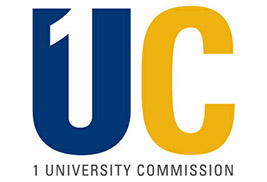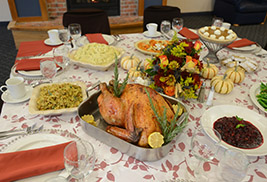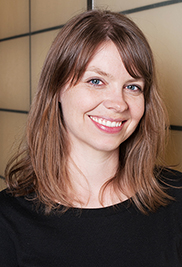eInside Briefs
News Briefs
- Commission Seeks Feedback to Strengthen University Multicampus System
- Kent State Chefs Share Thanksgiving Tips and Recipes
- Unwrapping Four Holiday Shopping Myths
- Kent State Professor Brings an Innovative Element to the Visual Communication Design World
Commission Seeks Feedback to Strengthen University Multicampus System

Kent State University's 1 University Commission (1UC) is
a presidential initiative charged with strengthening the
university system.
In her Listening Tour, Kent State University President Beverly Warren is hearing the uplifting stories of the university, and she understands that we can make Kent State stronger by emphasizing that as an institution we value each campus for its unique contribution to our mission and vision.
The 1 University Commission (1UC), a presidential initiative charged with strengthening our university system by creating more value for our students, our communities and our state, is collecting feedback via an online forum at http://theciviccommons.com/1uc and at listening posts at all campuses. Todd Diacon, Kent State’s senior vice president for academic affairs and provost, is chairing the commission.
Every few days, new questions in each of the four conversations will appear for added discourse. Please share your opinions as they relate to individual questions or groups of questions.
Questions already open for discussions include:
Academics and Curriculum
- Should the authority to determine course offerings at a Regional Campus reside with the Regional Campus dean, the Kent Campus dean or the department chair? Who should settle any disputes among the campuses? Please provide an explanation for your answer.
- What are the pros and cons of adopting a universitywide schedule of classes that coordinates the schedules among all campuses?
- Should the authority to determine face-to-face or online course instructors at the Regional Campus reside with the Regional Campus dean, the Kent Campus dean or the department chair? Who should settle any disputes among the campuses? Please provide an explanation for your answer.
Faculty Roles and Responsibilities
- What steps could we take to engage Regional Campus faculty in more research and varied teaching opportunities, including the graduate level?
- What steps could be taken to foster more inclusiveness between the Regional Campus faculty and their Kent Campus academic departments? Do you know of any specific examples that demonstrate this model of collegiality?
- What are the pros and cons of assigning faculty to teach at campuses other than their home campus? What are your ideas on how multiple assignments could be administered?
Structure and Leadership
- What do you think the appropriate title should be for each of Kent State's Regional Campus leaders? Currently, the title is Dean and Chief Administrative Officer.
- What do you think the appropriate title should be for the highest level administrator of Kent State's Regional Campus system? Currently, the title is Associate Provost for Kent State University System Integration.
- Should the highest-level administrator of the Regional Campus report to the Provost? If not, to whom should this person report and why?
Student Experiences
- In the spirit of "one university," how do we create a better sense of community?
- Discuss ways we can create more and better interactions between students and administration.
- What kinds of co-curricular activities (internships, programs, special clubs and student organizations) do you want on your campus?
Participation in the 1UC discussion is easy. There are three ways you can give your feedback:
- You can join a conversation on the Civic Commons.
- You can attend one of the listening posts to be held on all campuses.
- You can complete an online survey.
Share your opinion and share it often. We are one university; we are greater than the sum of our parts, and we are a force to be reckoned with in Ohio and the world.
back to top
Kent State Chefs Share Thanksgiving Tips and Recipes
Thanksgiving as told by the Kent State culinary team

Kent State University chefs J. Michael Fiala, Andrew
Eith and Timothy Wright serve up their favorite tips and
recipes to help make Thanksgiving a little more festive and
a little less frustrating.
A lot is expected of a Thanksgiving host. Preparation, cooking and entertaining can make the Thanksgiving feast begin to look overwhelming. This year, Kent State University culinary team members J. Michael Fiala, Andrew Eith and Timothy Wright serve up their favorite tips and recipes to help make Thanksgiving a little more festive and a little less frustrating.
Getting Ahead
Each of the professionals agrees that having a plan and getting organized is essential to a successful, stress-free Thanksgiving feast. Preparation is inevitable, but the process can be simplified.
“Dinner is a lot easier when you have a plan,” says Chef Fiala. “If you are responsible for cooking the entire meal, organize your recipes and start making a timeline.”
As the timeline unfolds, it is best to know what can be prepared ahead of time and what may not be feasible to cook from scratch. Chef Eith says that prepared items can, and should, be integrated into the meal to save time.
“Most people don’t want to spend all day in the kitchen, especially when entertaining,” Eith says. “Not every aspect of a holiday menu has to be scratch-cooked. If you’re planning a menu with a large plethora, then it may make sense to use that prepared pie shell or turkey base to help alleviate time in the kitchen.”
Sharing the Load
The Kent State culinary experts say being a first-class host does not mean making an entire meal on your own. As plans are being made, it may be wise to ask Aunt Susie to take care of the mashed potatoes this year. Preparing a Thanksgiving meal is a task best prepared by many hands.
“Have family and friends help as much as they can in the kitchen,” says Chef Wright. “Spend time together cooking, exchanging ideas and enjoying each other’s company.”
Even as a professional chef, Fiala knows it is best to divide and conquer the Thanksgiving feast. He advises hosts to have relatives bring elements of the meal to make the most of the holiday.
“In our family, I roast the turkey and bring the gravy,” Fiala says. “My older sister provides pies and libations. My younger sister will do a casserole. My mother sets the table, and my grandmother makes potatoes, sweet potatoes and appetizers. The kids do the dishes. Many hands make light work.”
Recipes from the Pros
Chef Eith:
Maronensuppe (German Chestnut Soup)
Ingredients
- 4 slices bacon, roughly chopped
- 2 tbsp. unsalted butter
- 1 large shallot, roughly chopped
- 1 medium carrot, roughly chopped
- 1 small leek, roughly chopped
- 1 stalk celery, roughly chopped
- 4½ cups chicken stock
- 2½ lb. fresh chestnuts, roasted and peeled, or two 15-oz. jars whole roasted chestnuts, drained
- 1 bay leaf
- 1 sprig thyme
- ½ cup heavy cream
- ½ tsp. freshly grated nutmeg
- Kosher salt and freshly ground black pepper, to taste
Instructions:
Heat bacon in a 6-qt. saucepan over medium-high heat; cook, stirring occasionally, until fat is rendered and bacon is almost crisp, 3–4 minutes. Add butter, shallot, carrot, leek, and celery; cook, stirring occasionally, until vegetables are soft, 5–7 minutes. Add stock, chestnuts, bay leaf, and thyme; bring to a boil. Reduce heat to medium; cook, slightly covered, until chestnuts are very tender, about 25 minutes. Remove from heat and let cool slightly. Discard bay leaf and thyme. Working in batches, purée soup in a blender until smooth. Return soup to saucepan and place over medium heat. Stir in cream, nutmeg, salt, and pepper; cook until soup is slightly thick, about 5 minutes more.
Blaukraut mit Cassis (Braised Red Cabbage)
- 42oz. (2 lbs. 10 oz.) fresh red cabbage
- Pinch of Salt
- 1 medium size yellow onion
- 1 sour-flavored apple (for example, Grannie Smith)
- 1 tablespoons butter + 1 tablespoon vegetable oil
- 8 oz. red currant juice
- 2 laurel bay leaves
- 1 cinnamon stick
- 3 cloves
- 4 Teaspoons Cassis (red currant liquor)
Instructions:
Clean the fresh red cabbage, remove trunk and cut into thin strips (julienne). Mix red cabbage with salt in a bowl. Alternatively, drain the red cabbage from glass jars. Peel and cut onions and apples into small cubes. Heat oil and butter mix in cooking pot or Dutch oven and fry onion and apple cubes for3 minutes until brown. Stir red cabbage into pan and fry for 2 more minutes. Add red currant juice, laurel, cinnamon and cloves, stir, cover and cook on medium heat for 30 minutes, stirring occasionally. Add cassis and season with salt and pepper, stir and serve.
Chef Fiala:
Cranberry Relish
- 2 bags fresh cranberries
- 4 oranges
- 1 whole pineapple
- 1 cup sugar
Instructions:
Zest the orange then peel and chop. Peel the pineapple, remove the core, cut into 1 inch cubes. In a food processor, grind the cranberries then place in a separate bowl. Grind the orange and pineapple, add to the cranberries. Add the orange zest and sugar, Stir and refrigerate overnight.
Chef Wright:
Grandma Wright’s Pecan Pie
- 1 8” unbaked pie shell
- 1 cup dark corn syrup
- 3 large eggs
- ½ cup light brown sugar firmly packed
- ¼ cup melted butter or margarine
- ½ tablespoon salt
- 1 cup broken pecan pieces
- 2 tablespoon light rum
- 1 teaspoon Vanilla extract
- ½ cup heavy cream, whipped (for topping)
Instructions:
Pre-heat oven to 350* degrees. Refrigerate pie shell until ready to fill. In a medium bowl, beat eggs with rotary beater, add corn syrup, sugar, butter and salt, beat until well combined. Stir in pecans and rum. Remove pie shell from refrigerator and pour filling into it. Bake 50-55 minutes and until filling is “set” in center when the pie is gently shaken. Remove from oven and cool on rack. To serve cut into 8”s and serve with a dollop of the whipped cream or ice cream.
Enjoying the Holiday
The most important ingredient to a flawless Thanksgiving dinner is leisure. Taking the time to enjoy a holiday with family and friends makes all the difference.
“Remember to relax,” says Fiala. “If dinner is scheduled at 1 p.m., but not ready until 3 p.m., don't worry, the person complaining would be more than happy to host next year.”
back to top
Unwrapping Four Holiday Shopping Myths

Colin Campbell, Kent State University
assistant professor, and Erik Zemljic,
Kent State doctoral student, both from
the Department of Marketing and
Entrepreneurship, clear up common
misconceptions about holiday shopping.
After a nice evening and many platefuls of turkey, stuffing and pie, it’s time to pull out those long wish lists and get down to business. Kicking off the shopping season can be stressful for you and your wallet, but there are ways to skate through the shopping frenzy without your bank account freezing over. A recent Gallup poll found that Americans are expected to spend an average of $781 this year on shopping, which could give you cold feet. So, we turned to two Kent State University experts to help us clear up common misconceptions about holiday shopping and to give you a few money- and time-saving tips so this holiday can truly be “the most wonderful time of the year.”
Myth No. 1 — I have to stand in line at 3 a.m. to get the best Black Friday deals.
Actually, stores have great deals online, too. Colin Campbell, Kent State assistant marketing and entrepreneurship professor, suggests that shoppers look for online deals first because many deals are the same as in the store. He says if you look online at home in your pajamas, you don’t lose as much valuable time.
Erik Zemljic, Kent State marketing and entrepreneurship doctoral student, suggests scoping out good online deals all year round.
“Instead of waiting to shop, you could find great deals throughout the year that would make the perfect gift for mom or a friend,” says Zemljic. “Buy it, put it in a box, and you’re ready for Christmas early. And you saved some money.”
Cyber Monday also is a great alternative to standing out in the cold on Black Friday and has some perks you can’t get in stores. Campbell says if you buy an item online and decide it doesn’t fit in the stocking, you can always return it in stores after the madness quiets down. Online deals also usually offer free shipping and much cheaper gift cards. Thanks to recent technological advances, you can shop smarter and save time and money with your smartphone. Zemljic says apps for your smartphone — like the one provided by Amazon — can be used to scan barcodes at the store and find cheaper prices online.
Myth No. 2 — If the item is sold out in stores, I missed a good deal.
If that must-have gift was sold out by the time you got to the store, don’t worry. Campbell reminds shoppers to use their smartphones not only at home but also while standing in line.
“Retailers only have a limited supply of popular items. Even if something sells out in the store, you can just jump online and purchase it that way,” says Campbell. “Or, if you’re standing in line for something at the store, you can be on your smartphone buying something else at the same time.”
Zemljic adds that deal forums like Slickdeals.net, which constantly post deals even after Black Friday is over, are becoming very popular and a good source for money-saving tips.
“If you don’t know a lot of information about a product or want to know if there are any deals anywhere for a similar product, just go online to a deal forum and post a question,” says Zemljic. “There will always be people who are really excited about this stuff and willing to help.” But use your best judgment — you can’t believe everything you read on the Internet!
Myth No. 3 — I should stay far away from my credit card during holiday shopping.
Many credit card companies provide their customers with a cash back reward program. Be sure to check your credit card’s reward policy. You may be eligible to regain a percentage of the amount you spend during holiday shopping. Campbell says some credit cards even have return protection and extended warranties.
“Even if you can’t return an item to the merchant, your credit card company may refund the full purchase price for you,” says Campbell. “Even better, a lot of credit cards will double your warranty for free, so you don’t have to buy the extra warranty in the store.”
Campbell suggests that everyone check with their credit card companies to see if you qualify for any reward incentives.
Myth No. 4 — The best gifts are the kind you buy.
Do-it-yourself (DIY) projects are fun and a great way to save a few extra bucks this year. Sites like Pinterest.com have plenty of DIY gift ideas for almost anyone in your family. Campbell even suggests homemade gifts like beer or wine because you can brew up a large portion to give to multiple people.
Zemljic says experience goods found on daily-deal sites like Groupon.com also are great gift-giving and money-saving options.
“Those types of sites are heavily concentrated on services,” says Zemljic. “Generally, you can get some really good deals for services like getting your nails done or a massage versus a tangible good. Something you can do with the person is cheaper and more fun than handing them a package.”
Hopefully these myth busters will take the pressure off door busters. Make the most of your holiday shopping this year by keeping yourself and your wallet happy. Using the tools at your disposal for saving money and saving time is a gift not only for your loved ones, but for yourself.
And that’s a wrap!
back to top
Kent State Professor Brings an Innovative Element to the Visual Communication Design World

Jessica Barness, assistant professor
in Kent State University's School of
Visual Communication Design, will co-edit
a special edition of the journal Visible
Language.
One Kent State University professor will have a hand in increasing the amount of overlap between traditional scholarly research and creative work in the design discipline.
Jessica Barness, assistant professor in Kent State’s School of Visual Communication Design, will co-edit a special edition of the journal Visible Language with Assistant Professor Amy Papaelias from the State University of New York at New Paltz. Visible Language is the oldest design research journal in existence, starting in 1967.
The special issue, “Critical Making: Design and the Digital Humanities,” will explore the point at which those two disciplines intersect in education and research.
“The digital humanities is an interdisciplinary approach to investigating human experiences in the networked, electronic information age,” Barness explains. “Historically, it's also been known as humanities computing. Research in this area focuses on digital technology and culture, as well as practices of building and inventing.”
Barness says the cross between the two disciplines is becoming more prominent.
“We’re seeing a crossover in that scholars in the digital humanities are designing their own research tools, and designers often create work that is outside of traditional client-based relationships,” she explains. "And both areas are dealing with content related to literature, museums or social media, for example.”
The difference between this issue and others is the incorporation of an online element dedicated to things like interactive reading experiences or works that exist as audio or video. Barness says this is not standard practice for design research journals.
“The idea that we brought to Visible Language was to do a hybrid issue that was printed but also has an online space that will host peer-reviewed creative, digital contributions,” Barness says. “Journals in a couple other areas are already doing this. We haven’t explored it very much in design, and we’re excited to have the support of Visible Language to do it.”
The issue is set to be published in October 2015, but in the meantime, Barness says she is discovering ways to incorporate the project into her curriculum.
“This spring, I’ll be teaching a graduate course called Critical Making in Design Research,” she says. “I plan to introduce how designing and making can be an active part of the research process, and not aimed toward developing commercially viable products. The students will design toward a better understanding of a topic or issue as part of a larger research agenda. They’ll be authoring and producing creative works that are also critical inquiries into human experience.”
Barness says she finds passion in this research because it challenges the typical expectations of what it means to be a designer.
“One thing I would call a misconception is that designers just make things look good; it’s something we constantly fight,” Barness says. “Our processes and approaches can also add value to team projects with people outside our areas of expertise.”
Overall, Barness says she and her co-editor aim to have the issue become an asset to design practice.
“We’re interested in pushing the boundaries of our discipline,” Barness says. “We want to see how the roles of designers can be expanded within our society.”
To learn more about the journal Visible Language, visit http://visiblelanguagejournal.com/about.
For more information about Kent State’s School of Visual Communication Design, visit http://www2.kent.edu/vcd/index.cfm.
back to top